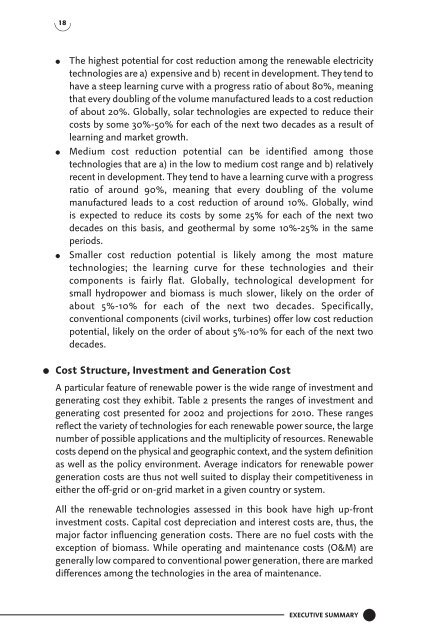Technology Status - NET Nowak Energie & Technologie AG
Technology Status - NET Nowak Energie & Technologie AG
Technology Status - NET Nowak Energie & Technologie AG
Create successful ePaper yourself
Turn your PDF publications into a flip-book with our unique Google optimized e-Paper software.
18<br />
● The highest potential for cost reduction among the renewable electricity<br />
technologies are a) expensive and b) recent in development. They tend to<br />
have a steep learning curve with a progress ratio of about 80%, meaning<br />
that every doubling of the volume manufactured leads to a cost reduction<br />
of about 20%. Globally, solar technologies are expected to reduce their<br />
costs by some 30%-50% for each of the next two decades as a result of<br />
learning and market growth.<br />
● Medium cost reduction potential can be identified among those<br />
technologies that are a) in the low to medium cost range and b) relatively<br />
recent in development. They tend to have a learning curve with a progress<br />
ratio of around 90%, meaning that every doubling of the volume<br />
manufactured leads to a cost reduction of around 10%. Globally, wind<br />
is expected to reduce its costs by some 25% for each of the next two<br />
decades on this basis, and geothermal by some 10%-25% in the same<br />
periods.<br />
● Smaller cost reduction potential is likely among the most mature<br />
technologies; the learning curve for these technologies and their<br />
components is fairly flat. Globally, technological development for<br />
small hydropower and biomass is much slower, likely on the order of<br />
about 5%-10% for each of the next two decades. Specifically,<br />
conventional components (civil works, turbines) offer low cost reduction<br />
potential, likely on the order of about 5%-10% for each of the next two<br />
decades.<br />
● Cost Structure, Investment and Generation Cost<br />
A particular feature of renewable power is the wide range of investment and<br />
generating cost they exhibit. Table 2 presents the ranges of investment and<br />
generating cost presented for 2002 and projections for 2010. These ranges<br />
reflect the variety of technologies for each renewable power source, the large<br />
number of possible applications and the multiplicity of resources. Renewable<br />
costs depend on the physical and geographic context, and the system definition<br />
as well as the policy environment. Average indicators for renewable power<br />
generation costs are thus not well suited to display their competitiveness in<br />
either the off-grid or on-grid market in a given country or system.<br />
All the renewable technologies assessed in this book have high up-front<br />
investment costs. Capital cost depreciation and interest costs are, thus, the<br />
major factor influencing generation costs. There are no fuel costs with the<br />
exception of biomass. While operating and maintenance costs (O&M) are<br />
generally low compared to conventional power generation, there are marked<br />
differences among the technologies in the area of maintenance.<br />
EXECUTIVE SUMMARY X







